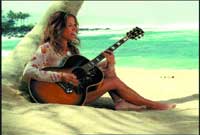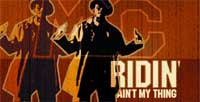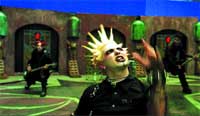
LA-based A Band Apart director Wayne Isham turned to the artists at Radium to help create the stylized look featured in two recent Sheryl Crow videos. For Crow's surfer-girl Soak Up the Sun (pictured), Radium's Santa Monica-based Flame artists bridged the video's various scenes in a water-themed fashion. The video Steve McQueen was inspired by the '60s films Bullet and The Great Escape, and incorporates effects created by the San Francisco-based Radium team, including freeze frames, repeating imagery and moving grids, all popular with the genre.
|
The client was director Mike Lipscombe. The video takes place in a dramatic gothic house with an interesting visual storyline. The song spans much of the singer's lifetime so the visuals cut between her happy childhood home and her chillier adult home. The artful transitions appear as washes, as color seeps over the walls and images of young children playing appear it reverses and color drains into a cold home where Hill performs.
To shoot on the two identical sets, Riot used a motion control camera system, the Milo from Santa Monica's Camera Control, along with a proprietary software for Maya camera data import. Discreet Inferno artist/visual effects supervisor Stefano Trivelli composited matte paintings with the live action and 3D effects. Maya was used for photoreal set extensions, camera tracking and 3D matte generation.
The challenge: Making seamless transitions between the two house sets, which were built nearly complete in three days. Quite an accomplishment, but not necessarily a precise one. The homes were not identical and the dimensions were off by a few inches. The trick was setting up the cameras in the exact same spots and lining up the footage in post. Before photography, Riot took extensive set surveys and, during, Trivelli worked with the motion control camera operator to manually keyframe the moves. They would run the move and split it to video tap with the previous take on a prior set. Whenever it would start to be a shift, they would work together to manually adjust the cameras.
SMART DESIGN
Rawkus Records knocked on Eyeball/ NY's (www.eyeballnyc.com) door and dropped off a live action transfer that was supposed to be a hip-hop music video. The footage had not been shot with visual effects or graphics in mind. The director had been released. The instructions were: do anything you can to make this great.
The performers were Mos Def, Nate Dogg and Pharoahe Monch, all black artists. They had been shot on a sparse stage against black with swinging lightbulbs or lighted signs. "Because we've got a strong foundation in design and direction, we really try to come up with metaphor or story that will tie the piece together, because a lot of times we're looking at four to five set-ups with no real reason for anything," says Limore Shur, Eyeball's creative director and owner.

Eyeball/NYC created a poster-like environment for the Oh No! video for Rawkus Records. It was cut on Edit; effects were created in 3DSMax, After Effects and other Adobe tools.
|
Eyeball created an environment like a poster, freezing the singers in key moments and posterizing them. The camera moves around them and comes back out. One special effect turns a singer's image into a baseball card. Type lyrics weave throughout live action. Eyeball spent a lot of time working on a technique that would solve the black on black problem - a lot of different passes of footage to separate highlights and medium tones from the black and dark areas so, at a moment's notice, the designers could pull out and separate them in order to put type or graphic elements moving behind them.
Eyeball cut the video using Discreet Edit but has since upgraded in another direction to Apple's Final Cut Pro. All graphic and visual effects elements were created using 3DSMax and Adobe After Effects, Photoshop and Illustrator. Eyeball is a design-inspired production company that does much of its own editing, directing of live action, and music and sound design.
"Any good program, story or visual that tells something interesting, it can be slow as a snail if it gets your attention," says Shur. "In TV, they're always saying it's all about branding or your network but it's all about good programming, too. It's not about how fast you cut things up, how quickly you throw around graphic elements; it's about doing good work, smart design and smart storytelling. That's how we work here. We try to hit on something that's the answer to every other question. If we can find that one element, that one metaphor that will drive the whole spot. Every designer/artist/editor understands that and it's easier for them to collaborate. In the end the piece looks really good and people don't understand why but they really like it."
SMART PACING
Deadstar Assembly's music video of Send Me an Angel, a hard rock/techno blend twisted version, is a "nice contrast of fast-paced performance with narrative going on. It's a Hollywood-like production. A little bit of both will keep viewers interested," says Adam Dearborn, art director at Battle Medialab (www.battlemedialab.com) in Hollywood, FL. It went on-air this fall.

Battle Medialab pushed its Avid DS to the max for this Deadstar Assembly video Send Me an Angel.
|
Battle Medialab handled the post end, including editing and graphics. This branding company spends 30 percent of its time creating music videos and touts its Avid|DS HD, which it uses for editing/compositing and graphics effects. It has done HD music video projects for Richie Marley among others.
Send Me an Angel comes from director Rip Odelbralski and his company Structured Chaos, also in Hollywood, FL. It is a full-fledged production with feature film values like full 3D CG, stunt coordinators involved with wirework, explosions and pyrotechnics, full sets, talent and makeup. The scene is post-apocalyptic. The band performs at a ruined temple; the narrative features a ship battle from which a crew member calls to an angel for help. It was shot on 35mm.
The challenge: There was a lot of integration of material from different sources and they had to test the limits of the Avid|DS with all the tracking, wire removal and color correcting. The film was transferred to Digi Beta, the CG work was done in Alias|Wavefront Maya. The tracking needed to combine the live action with the CG sets. The compositing dealt with explosions that were virtual and real. However, the post house bought the Avid|DS HD last year for just this kind of task.
"The main reason we decided on that tool was because it provided the most integrated, and most amount of, features," says Rod Molina, Battle's technical director. "Before we chose it we evaluated three separate systems in-house. HD was our number-one concern. Next was what we do - not just production, we do a lot of corporate design/media, Web or video - and we wanted something that would provide us with different features but be able to integrate them well. That's one thing that the DS is very good at: everything can be done at one workstation. We tested it against the Sony Xpri [before it was officially released] and a Jaleo system."
INTERESTING ELEMENTS
"This video is very kinetic. There's a marriage of a lot of things going on - things shot on location with very different set-ups, camera techniques and lenses used to apply different effects," says Omar Chavez, creative director of American Filmworks/ Miami (www. americanfilmworks. com), about Que Vivan Los Ninos, a music video for Latin American star Ana Christina through Sony Music International. Adds Marcelo Paez, one of the owners, "In this case we took a song that was very clich¥xpected, because it is targeted to kids, and we turned it into more like hip-hop performance video appealing to kids who now are on the edge. And we mixed it with animation that could have easily been developed by them, which attracts and identifies the audience."
American Filmworks is a production/ post house that edited and created special effects for this video. Music videos account for 75 percent of its business. In this case, American Filmworks created the video plus a one-minute open for a new fall show on Televisa Mexico. They also provided conceptual design and art direction.
The video juxtaposes children in classrooms, the singer's performance and a layer of traditional 2D line drawings that look as if children drew them. Adobe's Photoshop and After Effects were used to create and layer the drawings over the live action. To achieve a childlike effect, one technique involved using the 2D animation every three or four frames for a stop-motion feel. The transfer was done on a Thomson Spirit at Cineworks in Miami. Posting was done on the Media 100 844/X Version 1.1 which includes a helpful soft chromakeyer which made it easier to key out the blue, especially the fine hair edges of children.
The challenge: "There are always challenges when doing bluescreen and keying, and you want it to be as seamless as possible," says Chavez. "We were going for an imperfect effect but we didn't want the video itself to be imperfect." The solution was a marriage of technology and experience. It had to be shot right, lit right and posted correctly. It was shot on Super 16, some footage at high speed, some at low, some using 180-degree and 90-degree shutter angles. It was transferred at 15fps rather than 30fps to achieve a strobish look. One scene was given a particular texture during transfer. Another used natural light and shadows for perspective.
"The chromakey itself, there were certain specifications we couldn't get around," adds Paez. "We filtered it so it picked up some warmer skin tones. The blue came out very clean still thanks to color correction we were able to isolate them."